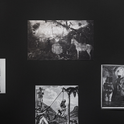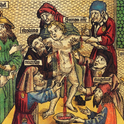Abu Bakr al Baghdadi, leader of IS, reportedly wounded this week. © Balkis Press/ABACA/Press Association Images
ISIS: Inside the Army of Terror by Michael Weiss and Hassan Hassan (Simon & Schuster, £7.99)
ISIS: the State of Terror by Jessica Stern and JM Berger (William Collins, £14.99)
There is a pronounced pessimism in our thinking about international politics. We are told the world is getting more dangerous. That the Cold War threat of nuclear annihilation was a pale shadow of the turmoil we see around us from Ukraine to Syria to Pakistan. Where states are strong—Russia and China—they are challenging the liberal order. Where states have crumbled, powerful rebel forces have arisen. In the Muslim world, a new caliphate has sucked thousands of previously peaceable European citizens into foreign battlefields. In a speech in March, the Foreign Secretary Philip Hammond caught the dystopian mood, warning of “new and unprecedented dangers” facing our world.
This panic hasn’t been eased by the spectacular rise of Islamic State (IS). A group dismissed by United States President Barack Obama in January last year as nothing more than a “jayvee team” wearing “Lakers uniform”—the British equivalent would be a pub team donning a Chelsea strip—has gone on to conquer territory the size of the United Kingdom, generating annual revenue of $300m a year and boasting 30,000 fighters. It has unleashed on the region its worst slaughter since Saddam Hussein’s Anfal campaign against the Kurds in 1988, in addition to systematic enslavement, torture and other war crimes. IS is a serious military threat to the Arab monarchies, and a lesser, though still serious, challenge to western countries.
But our inclination to treat IS as a unique phenomenon is clouding our judgement. As the journalists Michael Weiss and Hassan Hassan point out in their book ISIS: Inside the Army of Terror, the militant group is not a jihadi start-up that emerged from the ashes of Syria. It is a network whose roots long predate the Arab Spring and the age of social media.
Weiss and Hassan document the prehistory of IS, tracing its previous incarnations as al Qaeda in Iraq under the leadership of Abu Musab al-Zarqawi during the US occupation from 2003 onwards. They emphasise IS’s similarity to the jihadi groups from which it evolved: in its ideology, brutality, methods of war and aspirations to control territory. (Though so far it has been more successful in holding ground.) In ISIS: the State of Terror, the American researchers Jessica Stern and JM Berger cover similar ground, but the heart of their book is about the technology and psychology of IS. They too break down the illusion of novelty, by situating the militants’ sadistic tactics, apocalyptic ideas and social media dexterity in the context of other violent extremist groups. This may not be consolatory, but it is clarifying.
IS confuses western analysts because the group cuts across our traditional categories for understanding war. Makers of Modern Strategy, a seminal essay collection from 1943 edited by historians Gordon Craig and Felix Gilbert, did not include a single chapter on violence by non-state actors or rebels. In 1986 the collection was updated for the nuclear age, and was forced to account for everything from Mao to the mujahedin then terrorising Soviet troops in Afghanistan. “Revolutionary wars,” it declared, “occur within nations, and have as their aim the seizure of state power.”
IS fits awkwardly into this framework. It seeks war across nations, not just within them, a sort of irredentism previously seen in an ethnic guise—for example, the Kurds. And yet unlike al Qaeda, it seeks to be, or at least mimic, a territorial state. After conquering a suburb of Aleppo, write Weiss and Hassan, IS “fixed damaged roads, planted flowers, cultivated gardens, and cleaned the local schools,” in addition to embracing rudimentary environmentalism (they banned fishermen from using dynamite) and imposing price controls (a litre of oil was capped at 30 pence). IS’s violence may be frenzied, but it is not unthinking.
The ideological divergence between IS and al Qaeda is rooted in three key differences between al-Zarqawi, the Jordanian-born founder of the group that would become IS who was killed by the US in 2006, and Osama bin Laden. The first was Zarqawi’s embrace of takfirism, or excommunication of fellow Muslims, and his willingness to take on Muslim targets. The second was his targeting of Shia Muslims to provoke a response, and thereby force vulnerable Sunnis—just 30 to 40 per cent of Iraq’s population—into the welcoming arms of IS. And third was Zarqawi’s prioritisation of the “near enemy,” apostate regimes within the Middle East, against al Qaeda’s role as the “vanguard” of attacks on the “far enemy,” above all the US. These differences hit the headlines in February last year, when al Qaeda formally expelled IS, but the tension was evident 15 years ago, when Zarqawi—a “barely educated ruffian with an attitude,” as Stern and Berger put it—first met the more intellectual bin Laden around 1999 in Kandahar. Bin Laden suspected that Zarqawi’s group had been infiltrated by Jordanian intelligence, and he mistrusted the tattooed ex-con’s “rigid views.”
Since they took over Mosul last summer, IS has taken on the trappings of a state—keeping records, operating battlefield weapons and oil fields. It has been helped by incorporating remnants of Saddam’s state. The US decision to disband the Iraqi Army in May 2003 was calamitous. But Weiss and Hassan explain that in addition to a conventional army, Saddam also “constructed an entire underground apparatus for counterrevolution” in case he was overthrown. After Saddam’s fall, his Vice President, Izzat al-Douri, drew on his previous involvement in car smuggling and a network of mechanical repair shops to funnel car bombs to the insurgency. Douri was reportedly killed fighting with IS on 17th April.
Today, around a third of the deputies to Abu Bakr al-Baghdadi, the current leader of IS and self-proclaimed Caliph, are former Iraqi military officers. This does not mean Baghdadi is a fig leaf for a Saddamist resurgence—many of the former Baathists are now true believers. But IS’s growth has been fuelled by its willingness to form expedient alliances with non-jihadi Sunni groups. The cooperation between IS and Saddamists raises a broader question about the line between legitimate Sunni grievance, which smoothed the radical group’s path across Iraq last summer, and Sunni rejection of Iraq’s democratic and therefore Shia-dominated government.
"Despite having fewer Twitter followers than Jabhat al-Nusra, once an offshoot of IS and now al Qaeda’s affiliate in Syria, the IS hashtag has been tweeted four times as much as al Nusra’s"IS aren’t the only territorial jihadis. Al Qaeda’s Yemeni branch, Boko Haram in Nigeria and al Shabaab in Somalia all control territory. Boko Haram, which pledged loyalty to IS in March, controls 20,000 square miles with 1.7m Nigerians. Yet two aspects of IS’s behaviour stand out. The first is its proficiency with social media. The second is their use of spectacular, professionally filmed violence. Stern and Berger note that whereas much of al Qaeda’s propaganda consisted of tedious hour-long monologues delivered straight to camera, Zarqawi put out reams of battlefield footage, spliced into montages and set to Islamic a capella. The high-definition snuff movies made by IS, its sadistic documentaries hosted by British hostage John Cantlie, and its striking aerial shots of Fallujah by drone show they recognise the importance of modern media techniques.
To mark the declaration of its caliphate in June, IS released a slick magazine entitled Dabiq, and has put out seven more issues. Al Qaeda, by contrast, “had taken months to produce a single issue” of its English-language periodical, “and when it arrived, it was 117 pages of dull.” IS was also quick to exploit social media to broadcast its successes. Despite having fewer Twitter followers than Jabhat al-Nusra, once an offshoot of IS and now al Qaeda’s affiliate in Syria, the IS hashtag has been tweeted four times as much as al Nusra’s. This is the work of a 3,000-strong “social media battalion” as IS calls it, which aggressively circulates specific tweets to 45,000 pro-IS accounts and beyond. It provides the appearance of momentum and ubiquity well beyond the group’s real numbers and capabilities, and was particularly helpful in its early growth.
IS’s facility with media is more a product of its experience during 2003-2011 than, as sometimes thought, a lesson of the Arab Spring. The brutality of IS propaganda developed from the insurgency in post-invasion Iraq. A decade ago, between 2004 and 2006, IS’s forerunner, al Qaeda in Iraq, released 80 decapitation videos. This prompted al Qaeda’s then deputy leader Ayman al-Zawahiri to write to his affiliate, gently suggesting that “among the things which the feelings of the Muslim populace who love and support you will never find palatable… are the scenes of slaughtering the hostages.” Westerners have struggled to make sense of IS’s disregard for this advice, most recently in the video of the caged Jordanian pilot being burned alive. Stern and Berger argue that the group’s frequent exposure to violence is designed not just to instil terror in the west, but also “as a technology to erode empathy among its followers.” IS uses blunt knives in its killings to maximise the hostages’ pain, and gives blonde dolls to children to practice beheading. IS is traumatising an entire generation in order to normalise them to such tactics.
Perhaps the most interesting comparison to make is between IS and apocalyptic cults. Stern and Berger cite the examples of Heaven’s Gate and the Branch Davidians, whose members attempted, or were pressured into, mass suicide on the basis that the end was nigh. The eschatology of IS has found fertile soil. Seventy-two per cent of Iraqis believe they will personally witness the return of the Mahdi, a redemptive figure in Islamic prophecies. If they can persuade their followers that this is a cosmic war, as Stern and Berger write, “ordinary moral rules do not apply,” and untrammelled violence becomes acceptable. If in responding to IS western governments accept these terms of engagement—notably by cleaving to a clash of civilisations narrative—they reinforce the militants’ propaganda.
This goes to the heart of the debate raised by Graeme Wood in The Atlantic in March over whether IS can be considered Islamic. Berger has argued elsewhere that “extreme religious observance” is important to the group, but largely “as an identity marker, a signal to establish who is part of the in-group and who is part of the out-group”—who will survive the apocalypse and who will perish. Their unique feature is not their warped Islamic theology, but their millenarianism. This drives cult practices such as rituals of commitment (burning passports), punishing defection (executing disillusioned foreign fighters), sexual slavery of out-groups (such as Iraq’s “polytheist” Yazidi minority) and glorification of a mythologised leader (the Caliph). The combination of cult practices with mass mobilisation is also redolent of totalitarian movements. Put in those terms the sociological structure of IS looks more familiar, if no less frightening.
These books are both commendable second drafts of history. Weiss and Hassan’s book is better suited to those interested in the backstory of IS; how it deftly manoeuvred through Iraq’s tribal and sectarian geography, and the role of the US, Iran and Syria. Stern and Berger are strongest on its psychological warfare. IS’s lifespan as a proto-state might be short. But they have proved masters of re-invention and resilience and their ideological protégés, embedded in outposts from Libya to Pakistan, are likely to dominate global jihad for at least the next decade.













